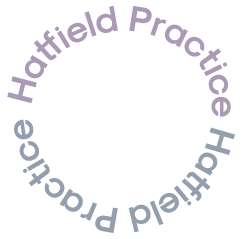The Hatfield Practice has provided solutions for back pain and sciatica since 1988. The Practice aims to provide you with professional, effective and affordable treatments. Please feel free to give us a call on Hatfield 01707 888229 and we will do our best to help you today.
The term “Sciatica” is derived from the nerves anatomy and description. Sciatica is a term commonly used to describe the pain travels when a spinal disc or nerve has been damaged or injured. Simply put sciatica describes the moderate to severe leg pain that often originates in the spine. The Sciatic nerve runs from the lower back, through the buttock and into the leg, foot and toes. Sciatica can be small moderate pains to extreme nerve pain which runs up or down the leg. The nerve gets stuck or caught up on a damaged disc or compressed by the bone thickening abilities of arthritis. Acute sciatica can make movements like bending forward or driving very painful. This sort of pain can progress to the point where simple tasks are hard to achieve. Symptoms may include back or leg pain, aching, numbness, stiffness, pulling, pins and needles. Sometimes sciatica may cause a man’s testicles to ache and occasionally in women a painful condition called vulvodynia i
Table of Contents
Sciatica? What Does it Really Feel Like:
- Typically intense pain ranging from stabbing to constant. Commonly presents as pain on one side of the leg but can be both. Patients often describe sciatica as deep, severe, stabbing, tingling or burning. Quite often the patient will present with focused points of pain often along the course of the nerves distribution.
- Sciatic nerve injury may cause discomfort when standing up, bending forward, walking and sitting down can aggravate the disc/ sciatic symptoms. Pain can also be a pain in the buttock, upper thigh and behind the knee.
- After severe sciatica, residual symptoms are common even after the initial pain has calmed down or after intense Physiotherapy, Acupuncture treatment. Patients may be left with weakness and intermittent pain in the affected muscles and foot.
- Discomfort from swollen nerves is common. The sciatic nerve may be unable to move freely in and out of the spinal canal due in part to adverse nerve tensions, swelling or local degenerative changes. Adverse Neural tension is essentially “sticking” or excessive nerve tightness. May present as an elastic band feeling in the affected leg. This Adverse Neural tension can come from a variety of causes such as disc bulge, degenerative spine changes, or scar tissue (David S. Butler) Symptoms of Neural tension can consist of painful spots known as trigger points along the hamstring or low leg muscles. The pain distribution may often follows the path of the sciatic nerve. Patients are often misdiagnosed as still having sciatica due to the many ways Adverse Neural tensionit can present.
What causes sciatica?
Older people often experience this type of pain due to changes within the spine due to conditions such as osteoarthritis in this way the sciatica is often caused by a narrowing of the disc. This can lead to bone spurs rubbing on the nerve. Whereas the younger generations experience Sciatic type of pain, from a bulging disc which pressed on the nerve exiting the side of the spine and can cause extreme pain. Other factors include:
- Footwear and long hours driving
- Being overweight and hypermobile
- Poor body conditioning with weakened muscles
- Naturally lax ligaments and “stretchy” discs I;e Soft connective tissue
- Trauma such as slipping, sport, lifting or car accidents
- Repetitive bending habits. This may happen over a long period of time.
- The patient has started a new job and does not have the specific conditioning to maintain good form.
- Poor manual handling techniques
How is Sciatica diagnosed?
Hatfield Practice is a great place to visit and was established in 1988. Providing Osteopathy, Physiotherapy, Acupuncturist and massage. Practitioners will take full medical case histories in order to diagnose your specific condition. Medically testing your back, hips, and legs for strength, flexibility, skin sensation, and reflexes in order to come up with a working diagnosis. If you are in extreme pain we will first calm the nerve through a series of gentle techniques. The Osteopath uses techniques to mobilise the spine (taking pressure off the damaged disc. Physiotherapy will provide treatments and exercises to strengthen your spine and associated muscles and Acupuncture stimulates the bodies endorphins which are powerful pain killers. We also use electrotherapy and Kino tape.
Most patients respond quickly to treatment within a week or two. Although if your symptoms persist or worsen it may be necessary to use strong pain killers or further than that an MRI to scan sections of discs, bones and tissues deep within your back. An MRI in most cases will help to show if there is a specific disc injury or arthritis pressing on a nerve in the spine. The Hatfield Practice specialist will discuss this with you. X-rays are often little help in this condition unless the pain is caused by spinal degeneration which may cause bone spikes called osteophytes which can trap nerves. X-rays only show the bones and not the soft tissues such as muscles and spinal discs.
How is Sciatica treated?
Osteopathy, Acupuncture and Physiotherapy have an essential role both for the acute painful episode (within two / three weeks) as well as long term pain which also responds well. Our ain is to provide you with solutions and education to prevent further episodes. The most common type of sciatica that we encounter responds well. Treatments consist of relieving pressure and inflammation off the sciatic nerve. Typical sciatica treatments include:
- Gentle Spinal mobilisation of the lower lumbar spine
- Acupuncture
- Electrotherapy
- Physiotherapy
- Release of muscle spasm.
- Traction of Lumbar spine manually
- Gently articulating the affected joints.
- Rehabilitation exercises.

How much does it cost for treatment?
Hatfield Practice currently offers £12.00 off your first professional consultation. Including Osteopathy, Acupuncture and Physiotherapy. Click here to find out our current price list and special offers. Our deep tissue massages are effective and deeply relaxing. Very useful once sciatica has settled. Deep tissue massage helps to ease the body of tensions in the muscles built up over time through work or stress.
Can I speak to anyone at the Hatfield Practice?
Yes! There is always somebody on hand to provide free telephone advice and support by calling Hatfield Practice reception on 01707 888229.
You are more than welcome to speak to any of our practitioners. Our e-mail [email protected] is monitored around the clock to provide assistance with any queries. The emergency number is our Clinical manager Ian Norman 07590924266.
Experience means everything
We have been in practice since 1988. We know that pain can be a real worry. Hatfield Practice reception team and Practitioner will do their best to help you. We pride ourselves in that we take our time and explain your symptoms and causes. Our promise is to do our best to ensure your Hatfield Practice experience is one to remember.. but don’t just take our word for it, we have over 500 reviews across Free Index , Google. and Facebook .






